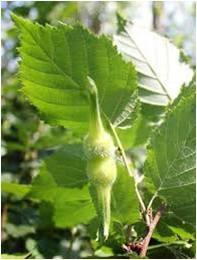Secwepemc name: nuts qá7p’ucw, qá7p’cw; bush: qe7p’ucwellp
 The nuts were an important food source for the traditional Secwepemc people. Mary Thomas tells of how her grandmother would put the freshly gathered nuts (still in their prickly husks) into a sack and bury it until the husk rotted, then the nuts would be easy to clean and shell for eating. The longer branches were used for the sweat lodge frame, but the mature wood was too brittle for other uses.
The nuts were an important food source for the traditional Secwepemc people. Mary Thomas tells of how her grandmother would put the freshly gathered nuts (still in their prickly husks) into a sack and bury it until the husk rotted, then the nuts would be easy to clean and shell for eating. The longer branches were used for the sweat lodge frame, but the mature wood was too brittle for other uses.
Ecological requirements; Grows in moist but well-drained soils, low to mid elevations, often in deciduous forests, in partial shade. Prefers locations where it is protected from wind and extreme temperature changes.
![]()
